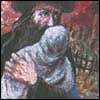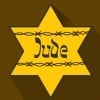Ernst Brager wasn’t taking any more chances. He had already been arrested twice by the Nazis and incarcerated both times in Sachsenhausen concentration camp.
The first time, he was released after serving a short sentence for the political crime of writing an anti-Nazi caption for an etching on display in an exhibition.
The second time, he was arrested for the crime of being a Jew after Kristallnacht, November 10, 1938, when synagogues, Jewish businesses and homes were burnt to the ground and thousands of Jews arrested.
With a forged passport, a small amount of personal belongings, and two Torah scrolls, he miraculously managed to flee GermanyBy tremendous Divine Providence, he had been released again. Hitler had one day decided that anyone who had been awarded the Iron Cross during the First World War, for fighting for the Fatherland, should not be in a concentration camp but should be freed immediately.
But Ernst understood that just as Hitler had suddenly, on the spur of the moment, decided to free some Jews, he was just as capable of changing his mind at the same speed.
With a forged passport, a small amount of personal belongings, and two Torah scrolls, he miraculously managed to flee Germany and meet up again in Paris with Gretel, his bride of only two weeks, who had fled separately.
Their visas to the USA were worthless, as there was no transport leaving to America. The only possibility was to get to Britain. However, to enter Britain they needed a financial guarantor who would promise that they wouldn’t be a burden on the British government.
Bernard Jacobson, an acquaintance from Hamburg, Germany, who now lived in London, responded to the request, agreeing to be their guarantor. So the young Brager couple started their new life in Golders Green, London.
The Torah scrolls were put to good use over the ensuing years. On Ernst’s death in 1986, his son David found them both in his parents’ home. He took them to a sofer (a religious scribe) to be checked. One was found to be totally and irreparably pasul (not kosher for use), and the second one needed extensive and expensive repairs.
Shortly afterwards, David and his wife Susan moved to Israel and brought the unrepaired Torah scroll with them. He took it to a sofer in Jerusalem who explained that it would be possible to cover the cost of repairing the scroll by lending it to a new congregation for fifteen years. They, in return, would pay for the cost of the repairs.
A contract was drawn up, and a new congregation in Rechovot, who were just starting out in a bomb shelter, were delighted to receive the now-kosher Torah.
Many years later David decided that the rental time must be over, and went in search of the contract to check the actual date and where the Torah had been placed. He turned his home upside-down, but to his surprise and consternation, he couldn’t find the contract anywhere. He didn’t worry too much, as he knew that the scribe who had worked on the scroll would have the details in his computer. But when the sofer checked on his computer, there was no record of David’s name. He remembered David, but decided that he must have made a mistake of some sort when it was entered into the database.
Each Torah scroll is allotted a number which is stamped on the parchment to identify it—but with no name, there was no way to check what the number was.
The only thing the sofer could suggest was that if David found what he believed to be his Torah scroll, he would enter the number on the Torah into his computer and hope that this would bring up David’s name as the owner.
But where could David start? It was obvious that the congregation which had started out in a bomb shelter sixteen years ago wouldn’t still be there. But who were they, and where were they now?
With just a photograph of the mantle they had made, indicating that the Torah scroll had been saved from the Nazis by his father, David set off in search of his Torah.
With just a photograph of the mantle they had made, indicating that the Torah scroll had been saved from the Nazis by his father, David set off in search of his TorahThe old bomb shelter where his Torah had first been lent was now empty. The original group who had used the shelter for their services had split up into four new congregations, and no one in the adjoining apartments knew where they were now located.
David wandered around the area, going from synagogue to synagogue, speaking to the congregants but without getting any leads as to the whereabouts of his Torah.
Willing to try anything, David walked into the Rechovot Municipality intending to ask if there was a way of checking where the congregations who used those bomb shelters had transferred to. Divine Providence took over again, ensuring that Yonit Kopelowitz was at her desk. After he told her his story, to his surprise she said that she had moved to the area about seventeen years ago, around the time that David had rented out his Torah. She remembered the bomb shelters that David referred to, and knew where the congregations were now located.
Yonit suggested he leave the problem with her, and she would contact the congregations. She found them all, but none of the members had any recollection of David’s Torah. Nor could it, with its distinctive mantle, be found in the Torah ark of any synagogue in the area.
When David called, she told him of her lack of success so far, but added that her husband, Jonathan, very much wanted to try and find the Torah for him. Two days later Jonathan called and said he had located it in a yeshiva in the Shomron. The community where it had originally been placed had passed it on, probably having no idea that it was on temporary loan and its owner would one day come back looking for it.
However, although the cover was definitely David’s, he had to check that the cover hadn’t been placed on a different Torah in the intervening years.
He noted down the numbers stamped on the parchment and returned to the scribe who entered the numbers into his computer. It immediately brought up David’s name, but instead of the surname Brager, it had the name Prager, thus explaining why the he hadn’t been able find it in his database.
Having now retrieved his father’s Torah, David wanted once again to find a new home in which a Torah scroll was desperately needed.
A friend told him of a yeshiva of boys from England that was starting out and was in need of a Torah, and David suggested that if they were interested, they should call him.
Shortly afterwards he received a call, and a voice on the line introduced himself as Rabbi Moshe Jacobson. David’s heart stopped for a moment.
“Was your father or grandfather Mr Bernard Jacobson of London?”
“Yes indeed, he was my grandfather.”
The Torah could not have found a more appropriate homeThe Torah could not have found a more appropriate home. Can you imagine how proud Bernard Jacobson would have been to know that the very Torah that his generosity helped rescue from the Nazi flames would now be used in a yeshiva in Israel under the guidance of his own grandson?
The Brager family’s debt of gratitude had at last been paid.
Postscript: The Torah scroll’s long circular journey ended on Sunday, March 6, 2011, Rosh Chodesh Adar Bet, when it was officially brought to its new home at Yeshivat Keter HaTalmud in the Ramat Eshkol neighborhood of Jerusalem, accompanied by exuberant singing, dancing and a festive meal.
Chief Rabbi of Israel Rabbi Yona Metzger honored the donors, the Brager family and the yeshiva by being present at the ceremony.
It was a small but very emotional event, as the Brager family met up with the rabbis and students of the yeshiva, many of whose parents and grandparents they themelves remembered, and amongst whom their parents Ernst and Gretel Brager had lived during the postwar years in London.








Join the Discussion